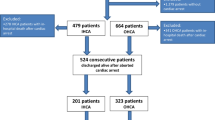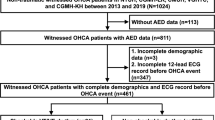Abstract
Introduction
Acute neurological injury and several medications commonly administered in the Neuro ICU pose a risk of fatal cardiac dysrhythmias. The objective of this study is to identify the predictors of ventricular dysrhythmias in the Neuro ICU patients with prolonged QTc, thereby helping the clinicians make important treatment decisions.
Methods
We performed a retrospective review of all consecutive adults admitted to the Neuro ICU from January 2015 to September 2015 with a QTc interval ≥ 450 ms on electrocardiogram.
Results
A total of 170 patients with a mean age of 66 years (SD ± 16) were included in the final analysis. Eighty-seven patients (51%) were women. Median duration of hospitalization was 9 days (IQR 4–16). Most common primary diagnosis was ischemic stroke (38%) followed by cerebral hemorrhage (19%) and subarachnoid hemorrhage (8%). Mean QTc was 487 ms (SD ± 35, range 450–659 ms). There were 27 episodes (16%) of monomorphic non-sustained ventricular tachycardia and one episode of Torsades (1%). Three cardiac arrests (2%) were recorded, none resulting from ventricular dysrhythmias. In multivariate analysis, prolonged QTc ≥ 492 ms (p = 0.0008), supratentorial acute ischemic stroke (p = 0.005), prolonged hospitalization (p = 0.03), and premature ventricular complexes on ECG (p = 0.047) were all independently associated with increased risk of ventricular dysrhythmias.
Conclusions
In this group of patients with prolonged QTc in the Neuro ICU, we observed several episodes of non-sustained ventricular tachycardia and identified important risk factors associated with their occurrence. This knowledge is essential to inform clinical decisions.

Similar content being viewed by others
References
Drew BJ, Ackerman MJ, Funk M, et al. Prevention of torsade de pointes in hospital settings: a scientific statement from the American Heart Association and the American College of Cardiology Foundation. Circulation. 2010;121:1047–60.
Bazett HC. An analysis of the time-relations of electrocardiograms. Heart. 1920;7:353–70.
Niemeijer MN, van den Berg ME, Deckers JW, et al. Consistency of heart rate-QTc prolongation consistency and sudden cardiac death: The Rotterdam Study. Heart Rhythm. 2015;12:2078–85.
Zipes DP, Wellens HJ. Sudden cardiac death. Circulation. 1998;98:2334–51.
Katritsis DG, Zareba W, Camm AJ. Nonsustained ventricular tachycardia. J Am Coll Cardiol. 2012;60:1993–2004.
Ng TM, Olsen KM, McCartan MA, et al. Drug-induced QTc-interval prolongation in the intensive care unit: incidence and predictors. J Pharm Pract. 2010;23:19–24.
Tisdale JE, Wroblewski HA, Overholser BR, Kingery JR, Trujillo TN, Kovacs RJ. Prevalence of QT interval prolongation in patients admitted to cardiac care units and frequency of subsequent administration of QT interval-prolonging drugs: a prospective, observational study in a large urban academic medical center in the US. Drug Saf. 2012;35:459–70.
Tseng PT, Lee Y, Lin YE, Lin PY. Low-dose escitalopram for 2 days associated with corrected QT interval prolongation in a middle-aged woman: a case report and literature review. Gen Hosp Psychiatry. 2012;34(210):e13–5.
Wenzel-Seifert K, Wittmann M, Haen E. QTc prolongation by psychotropic drugs and the risk of Torsade de Pointes. Deutsch Arzteblatt Int. 2011;108:687–93.
Samuels MA. The brain-heart connection. Circulation. 2007;116:77–84.
Gregory TSM. Cardiovascular complications of brain injury. Contin Educ Anaesth Crit Care Pain. 2012;12:67–71.
Frontera JA, Parra A, Shimbo D, et al. Cardiac arrhythmias after subarachnoid hemorrhage: risk factors and impact on outcome. Cerebrovasc Dis. 2008;26:71–8.
Al-Khatib SM, LaPointe NM, Kramer JM, Califf RM. What clinicians should know about the QT interval. JAMA. 2003;289:2120–7.
Moss AJ. Long QT syndrome. JAMA. 2003;289:2041–4.
Crow RS, Hannan PJ, Folsom AR. Prognostic significance of corrected QT and corrected JT interval for incident coronary heart disease in a general population sample stratified by presence or absence of wide QRS complex: the ARIC study with 13 years of follow-up. Circulation. 2003;108:1985–9.
Katsanos AH, Korantzopoulos P, Tsivgoulis G, Kyritsis AP, Kosmidou M, Giannopoulos S. Electrocardiographic abnormalities and cardiac arrhythmias in structural brain lesions. Int J Cardiol. 2013;167:328–34.
Marafioti V, Rossi A, Carbone V, Pasqualin A, Vassanelli C. Prolonged QTc interval is a powerful predictor of non-cardiac mortality in patients with aneurysmal subarachnoid hemorrhage independently of traditional risk factors. Int J Cardiol. 2013;170:e5–6.
Katritsis DG, Camm AJ. Nonsustained ventricular tachycardia: where do we stand? Eur Heart J. 2004;25:1093–9.
Moss AJ, Schwartz PJ, Crampton RS, et al. The long QT syndrome. Prospective longitudinal study of 328 families. Circulation. 1991;84:1136–44.
Sauer AJ, Moss AJ, McNitt S, et al. Long QT syndrome in adults. J Am Coll Cardiol. 2007;49:329–37.
Reinelt P, Karth GD, Geppert A, Heinz G. Incidence and type of cardiac arrhythmias in critically ill patients: a single center experience in a medical-cardiological ICU. Intensive Care Med. 2001;27:1466–73.
Pickham D, Helfenbein E, Shinn JA, et al. High prevalence of corrected QT interval prolongation in acutely ill patients is associated with mortality: results of the QT in Practice (QTIP) Study. Crit Care Med. 2012;40:394–9.
Scheitz JF, Nolte CH, Doehner W, Hachinski V, Endres M. Stroke-heart syndrome: clinical presentation and underlying mechanisms. Lancet Neurol. 2018;17:1109–20.
Funding
Funding was received from the Dubie Hulliman Heart and Cancer Fund through the Wake Forest School of Medicine Medical Student Research Program.
Author information
Authors and Affiliations
Contributions
Megan Garzon contributed towards study concept and design, data collection and writing the first draft of the manuscript. Kelly Fuhrmann contributed towards data collection from pharmacy standpoint. Christopher McLouth contibuted towards data analysis. Dr. Vachharajani contributed towards interpretation of data and revising the manuscript for content. Dr. Datar contributed towards study concept and design, data collection, analysis, data interpretation and revising the manuscript for content.
Corresponding author
Ethics declarations
Conflict of interest
The authors declare that they have no conflict of interest.
Informed Consent
We confirm adherence to ethical guidelines and IRB approval for this study. Waiver of written informed consent was requested and approved by the IRB.
Additional information
Publisher's Note
Springer Nature remains neutral with regard to jurisdictional claims in published maps and institutional affiliations.
Electronic supplementary material
Below is the link to the electronic supplementary material.
Rights and permissions
About this article
Cite this article
Garzon, M.E., Fuhrmann, K.M., McLouth, C.J. et al. Predictors of Ventricular Dysrhythmias in Neurology Intensive Care Unit Patients with Prolonged QTc. Neurocrit Care 33, 769–775 (2020). https://doi.org/10.1007/s12028-020-00954-y
Published:
Issue Date:
DOI: https://doi.org/10.1007/s12028-020-00954-y




